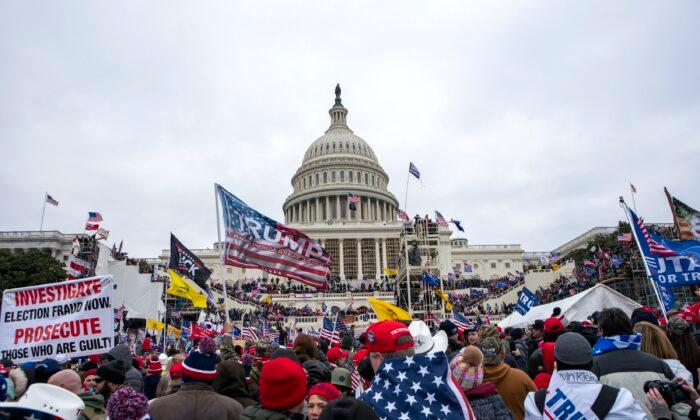When one such claim is based on a single vote in Congress, then it’s high time to review the Constitution’s Speech and Debate Clause. When yet another claim is based on a public speech, it’s time to examine the First Amendment.
Rep. Jim Banks (R-Ind.) is the subject of one “disqualification” proceeding. Rep. Madison Cawthorn (R-N.C.) is the subject of another.
The claim against Cawthorn is that he addressed the pro-Trump crowd in Washington on the same day and that this was likewise “insurrection.”
The accusers rely on Section 3 of the 14th Amendment. It reads in part as follows: “No person shall be a Senator or Representative in Congress ... who, having previously taken an oath, as a member of Congress ... to support the Constitution of the United States, shall have engaged in insurrection or rebellion against the same.”
What Does ‘Insurrection’ Mean in the Constitution?
Today we think of “insurrection” as an open rebellion against the government, usually by armed revolutionaries. If we apply that modern definition, then obviously, neither congressman came close to insurrection. Neither was part of the Capitol breach, and there’s little if any evidence that even those who did enter the Capitol intended to overthrow the government.However, in applying the Constitution, we don’t rely on modern definitions. We examine definitions as they existed when the original document—or the relevant amendment—was ratified. Moreover, we presume that when a word or phrase in an amendment also appears in the original Constitution, the word or phrase in the amendment means the same as it does in the original document.
The term “insurrection” appears in Article I, Section 8, Clause 15 of the original Constitution. When the Constitution was ratified, Samuel Johnson’s famous “A Dictionary of the English Language” was the leading work of its kind. Johnson defined “insurrection” as “a seditious rising, a rebellious commotion.” He described “seditious” as “factious with tumult; turbulent.”
When interpreting a constitutional word, you should never rely on just one dictionary. Accordingly, I checked several other 18th-century dictionaries, and they all had similar definitions.
As you can see, 18th-century English speakers used “insurrection” more loosely than we do. Still, their definition requires a crowd “rising” in “tumult” or “turbulence.” A mere protest doesn’t qualify as an insurrection.
Obviously, by the original Constitution’s meaning, Banks’s congressional vote wasn’t “insurrection.”
“In advance of the riot at the Capitol, [Cawthorn] met with planners of the demonstrations and tweeted that ’the future of this Republic hinges on the actions of a solitary few. ... It’s time to fight,'” the opinion piece reads.
“He spoke at the pre-attack rally at the Ellipse, near the White House, where he helped work the crowd into frenzy, saying that the crowd had ’some fight in it‘ and that the Democrats were trying to silence them. And in the aftermath of the mob violence, he extolled the rioters as ’political hostages’ and ‘political prisoners,’ and suggested that if he knew where they were incarcerated, he would like to ‘bust them out.’”
Was this insurrection?
First, Cawthorn “met with” those planning the demonstration. But there’s no evidence that they were planning any violence or disorder. They were planning a peaceful demonstration, and the overwhelming majority of the participants did, in fact, remain peaceful—just as President Donald Trump asked them to be.
A few people outside the official planning group were plotting disorder, but there’s no allegation that Cawthorn met with them, let alone encouraged them.
Third, Cawthorn is charged with stirring up the crowd. But that’s the job of a speaker at a political rally. No one is placed on a political podium and told to be boring.
Fourth, there’s no allegation that Cawthorn incited violence or illegal conduct of any kind.
Fifth, when the “tumult” arose, it didn’t arise among those who heard his speech at the Ellipse. It began at the Capitol, a mile and a half away.
Thus, even the unrebutted charges outlined in the hostile NY Times fall well short of the loose 18th-century definition of “insurrection.”
But should we apply an 18th-century definition to a 19th-century amendment? I mentioned that the amendment’s use of a term is presumed to be the same as in the original Constitution. However, that presumption can be rebutted if there’s a good reason for doing so.
Let’s see if the 19th-century meaning differed from the 18th-century meaning. In the 19th century, the leading U.S. dictionary was Noah Webster’s. It defined “insurrection” as follows: “A rising against civil or political authority; the open and active opposition of a number of persons to the execution of law in a city or state. It is equivalent to sedition, except that sedition expresses a less extensive rising of citizens.”
Webster’s dictionary described “sedition” as “a factious commotion of the people, or a tumultuous assembly of men rising in opposition to law or the administration of justice, and in disturbance of the public peace.”
I’ve confirmed that other 19th-century dictionaries had similar entries.
The 19th-century definition would seem to require more direction than the 18th-century meaning, as well as organized and violent resistance to the law.
The Speech and Debate Clause and First Amendment
We shouldn’t leave matters there. We should also consider what kind of people would bring charges like this.The Speech and Debate Clause is a core part of our constitutional inheritance. It comes from the English Bill of Rights of 1689. The English version was adopted to prevent tyrannical kings and other officials from punishing members of Parliament for what they said or how they voted. The U.S. Founders duplicated it in the Constitution to protect members of Congress from official reprisals and intimidation, including recrimination from unfriendly state election boards.
In other words, when Banks’s accusers seek to disqualify him for how he voted on the floor of Congress, they stand in the tradition of tyrannical English kings.





